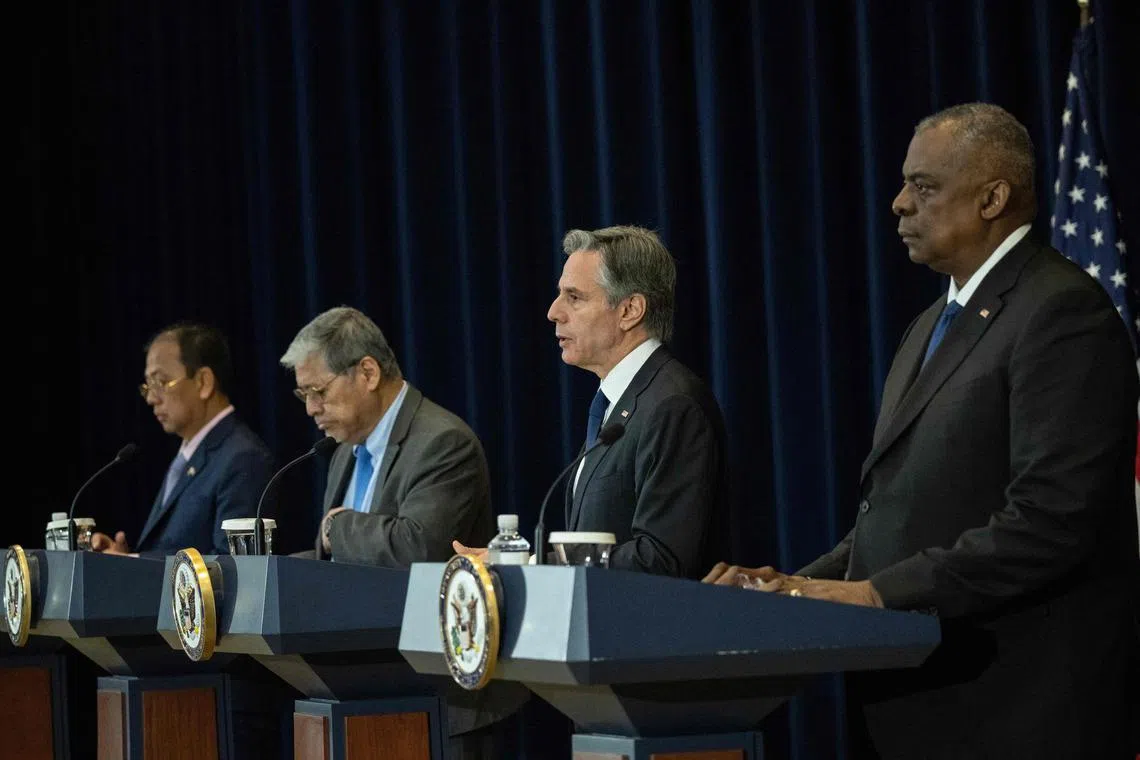US, Philippines agree to complete security assistance road map in 5-10 years
Sign up now: Get ST's newsletters delivered to your inbox

A so-called "2+2 meeting" in Washington on April 11 involved (from left) Philippine National Defence Senior Undersecretary and Officer-in-Charge Carlito Galvez, Philippine Foreign Secretary Enrique Manalo, US Secretary of State Antony Blinken, and US Defence Secretary Lloyd Austin.
PHOTO: AFP
Follow topic:
WASHINGTON – The top defence and diplomatic officials from the US and Philippines agreed on Tuesday to complete a road map on US security assistance to the Philippines in the next five to 10 years, US Defence Secretary Lloyd Austin said on Tuesday.
Mr Austin said the long-time allies discussed the delivery of “priority defence platforms”, including radars, drones, military transport aircraft and coastal and air defence systems at a so-called “2+2 meeting” in Washington, which also involved US Secretary of State Antony Blinken and the Philippine counterparts of Mr Austin and Mr Blinken.
Philippine Foreign Minister Enrique Manalo said the two sides “redoubled” their commitment to modernising the Philippine-US alliance in recognition that “our partnership will need to play a stronger role in preserving an international law-based international order”.
Experts, including former US defence officials, say the United States sees the Philippines as a potential location for rockets, missiles and artillery systems to counter a Chinese amphibious invasion of Taiwan, which China claims as its own.
Mr Austin said that it was “too early” to discuss what assets the US would like to station at military bases in the Philippines under a recently expanded Enhanced Defence Cooperation Agreement (EDCA).
Mr Manalo said the EDCA sites were mainly aimed at improving military interoperability and addressing potential humanitarian disasters, “and perhaps respond to other types of security challenges”, but did not elaborate.
The Pentagon has not specifically said what the additional sites will be used for, except that work would include airport expansion and training involving naval assets.
Mr Manalo said on Monday that Washington and Manila will need to discuss what the US may do with its access to the EDCA sites.
The agreement allows US access to Philippine bases for joint training, pre-positioning of equipment and building of facilities such as runways, fuel storage and military housing, but not a permanent presence.
Relations between the two countries have warmed considerably under Philippine President Ferdinand Marcos Jr, and the 2+2 meeting underlined that as the first of its kind in seven years. But Manila treads a delicate path with China, the region’s economic powerhouse.
Mr Marcos assured China on Monday that military bases accessible to the US would not be used in offensive action,

